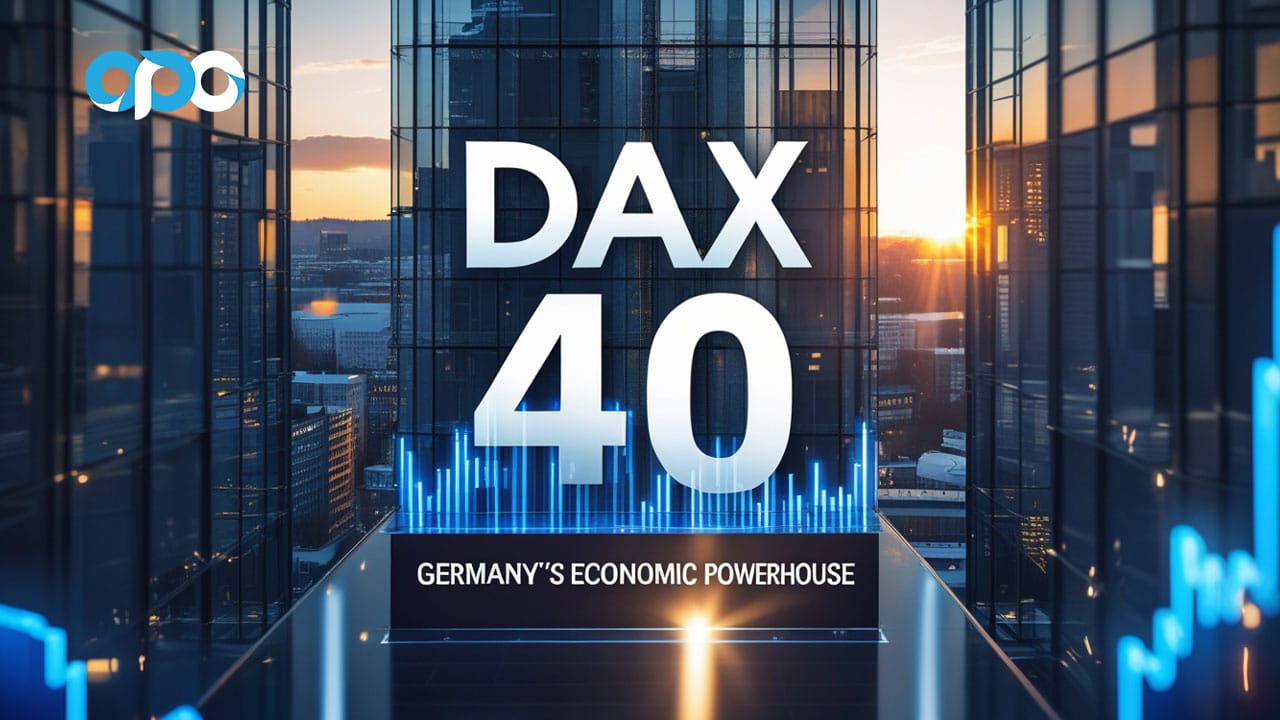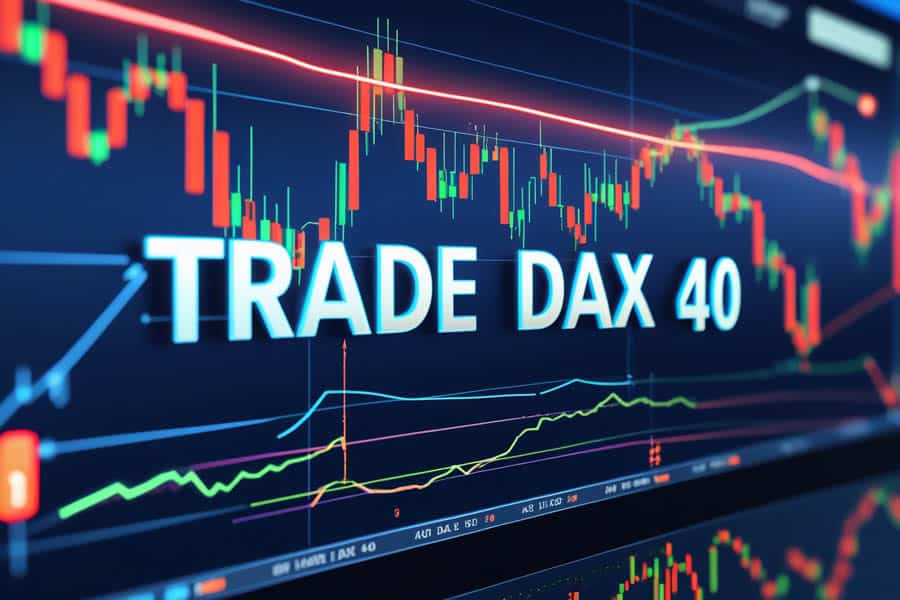Are you seeking a reliable indicator to gauge the financial health of Europe’s leading economy? The answer lies in understanding the DAX 40 Index, also known as the Germany 40 Index or the German Stock Index DAX. This crucial benchmark, frequently discussed as what is GER 40 Cash or even what is ger40 in forex trading circles, serves as the definitive measure for the German stock market and offers valuable insights into the health of the broader European economic landscape. Like a seasoned broker for forex trading guiding your investment decisions, this comprehensive article will illuminate the multifaceted nature of the DAX 40. We will meticulously explore its composition, delve into its calculation, analyze its profound significance, and examine recent developments impacting this pivotal index, providing a thorough understanding for both novice and experienced investors. This deep dive will equip you with the knowledge to interpret this vital economic signal.

Understanding the DAX 40 Index
The DAX 40 Index transcends being merely a list of Germany’s most prominent companies; it functions as a dynamic and responsive indicator reflecting prevailing investor sentiment and underlying economic trends. Comprehending its subtle nuances is paramount for anyone actively involved in global finance or holding an interest in the performance of leading European businesses. This understanding allows for informed decision-making and a greater appreciation of the interconnected global economy.
A Journey Through Time: Historical Roots of the DAX

The narrative of the German Stock Index DAX commenced in 1988, marking the genesis of a critical benchmark for the German financial market. Initially, the index was composed of 30 of Germany’s largest and most actively traded publicly listed companies. This carefully curated group swiftly established itself as the primary and most dependable gauge of the German stock market’s overall health and stability. For over three decades, the “DAX 30” remained a constant and recognizable fixture in financial news cycles and in-depth market analyses, becoming virtually synonymous with German economic performance. However, recognizing the ongoing evolution and diversification of the German economy, and acknowledging the growing need for a more representative and inclusive benchmark, a significant and widely anticipated transformation unfolded in September 2021.
This pivotal moment in the DAX’s history involved a strategic and significant expansion of the index, increasing its composition from the long-standing 30 constituents to a more comprehensive and representative 40 companies. This strategic augmentation was not simply a numerical adjustment; it represented a deliberate and thoughtful effort to furnish a more granular and accurate depiction of the broader German corporate landscape. By incorporating additional significant players from a wider array of both emerging and well-established sectors, the index aimed to more faithfully reflect the inherent dynamism and complexity of the modern German economy. This evolution, transitioning from the familiar DAX 30 to the robust and widely followed DAX Performance Index that we recognize today, marked a crucial turning point in its history, unequivocally solidifying its position as the preeminent indicator of German economic vitality and enhancing its relevance and influence on the global financial stage.
Here’s a more detailed look at key milestones:
- 1988: The Inception of the DAX. The original DAX index, consisting of 30 top German companies, is launched, providing an initial benchmark for the nation’s stock market.
- Early Years: Establishing Credibility. The DAX quickly gains recognition and becomes the primary indicator for tracking the performance of the German economy. Its movements are closely watched by investors and economists.
- Technological Advancements: Embracing Electronic Trading. The transition to electronic trading systems significantly improves the efficiency and speed of trading for DAX-listed companies, enhancing liquidity.
- Economic Shifts and Global Events: Navigating Challenges. The DAX navigates various economic cycles and global events, demonstrating its resilience and importance as a gauge of economic sentiment.
- September 2021: The Expansion to DAX 40. A landmark decision is made to expand the index to 40 companies, reflecting the growth and diversification of the German economy and aiming for a more comprehensive representation of its corporate landscape. This included stricter profitability requirements for new entrants.
- Post-Expansion Era: Adapting to a New Landscape. The expanded DAX 40 continues to serve as the leading indicator, with its broader composition providing a more nuanced view of the German market.
Read More: What Is the Dow Jones Industrial Average?
Defining the Roster: DAX 40 Composition Explained

The selection process for including a company in the prestigious DAX 40 Index is a meticulously structured procedure, far removed from arbitrary decisions. Rigorous and clearly defined criteria are diligently applied to ensure that only the most significant and demonstrably financially sound entities are granted the privilege of membership. These stringent criteria primarily concentrate on two pivotal factors: the company’s market capitalization, which represents its overall market value and influence, and the liquidity of its shares, which indicates the ease and efficiency with which its shares can be bought and sold in the open market without causing significant price fluctuations. Specifically, companies aspiring to become a component of the what is GER 40 Cash must be officially listed on the Prime Standard segment of the Frankfurt Stock Exchange. This listing itself signifies a commitment to a high level of transparency, stringent regulatory compliance, and internationally recognized accounting standards. Furthermore, these prospective constituent companies must consistently demonstrate a substantial and robust level of trading volume to definitively ensure that the index remains a genuine and accurate reflection of active market participation and investor interest.
The current composition of the DAX Performance Index reads like an authoritative register of German industry titans, effectively showcasing the nation’s formidable economic power and global influence. Within its distinguished ranks, you will discover globally recognized giants representing a remarkably diverse spectrum of sectors that collectively drive not only the German economy but also significantly contribute to the broader global economic engine. These prominent sectors and some of their representative companies include:
- Automotive: Representing Germany’s engineering prowess and global automotive leadership, key constituents include Volkswagen (VOW.DE), Mercedes-Benz Group (MBG.DE), and BMW (BMW.DE).
- Software and Technology: Highlighting Germany’s growing prominence in the technology sector, SAP (SAP.DE) stands as a flagship company.
- Chemicals: Showcasing the strength of Germany’s industrial backbone, BASF (BAS.DE) and Linde (LIN.DE) are key players.
- Insurance: Representing the financial stability and security sector, Allianz (ALV.DE) is a leading example.
- Utilities: Essential for infrastructure and energy, E.ON (EOAN.DE) and RWE (RWE.DE) are prominent constituents.
- Pharmaceuticals and Healthcare: Reflecting advancements in life sciences, Bayer (BAYN.DE) and Merck (MRK.DE) are significant members.
- Consumer Goods: Representing well-known brands, Adidas (ADS.DE) and Henkel (HEN3.DE) are included.
The collective performance of these influential companies, meticulously tracked and accurately reflected in the dynamic movements of the DAX 40 Index, furnishes invaluable insights into the overarching strength, prevailing direction, and anticipated future prospects of the German economy. This carefully selected collection of leading enterprises effectively transforms the index into a potent and reliable barometer of German economic well-being.
Read More: What is FRA40 Index
Understanding DAX 40 Calculation
The DAX 40 Index is not a simple arithmetic average of the stock prices of its constituent companies. Its calculation employs a sophisticated free-float methodology, a crucial aspect that distinguishes it from some other indices. This methodology means that when determining a company’s weighting within the index, only the shares that are readily available for public trading are taken into account. Shares held by company insiders, governments, or other entities with restricted trading rights are excluded from this calculation. This approach provides a more accurate and realistic representation of the actual market value that is accessible to investors, ensuring the index truly reflects market sentiment.
The formula for calculating the DAX 40 Performance Index is as follows:
Index Value = ( Σ (Pi * Si * FFi) ) / Divisor
Where:
- Pi = Price of component stock i
- Si = Number of outstanding shares of component stock i
- FFi = Free-float factor of component stock i (between 0 and 1)
- Σ = Summation across all 40 component stocks
- Divisor = A proprietary figure adjusted to maintain index continuity after capital changes, stock splits, etc.
Furthermore, it is critically important to understand the fundamental distinction between the performance index and the price index when analyzing the DAX 40. The DAX Performance Index is the standard benchmark typically quoted in financial news and analysis. Crucially, this version of the index takes into full consideration the impact of dividend payments made by the constituent companies. This means that the index not only reflects the changes in the share prices (capital appreciation) but also includes the income generated from dividends, providing a holistic view of the total return to investors. A price index, in contrast, solely considers the fluctuations in the prices of the underlying stocks, excluding any dividend payouts. Therefore, when you encounter a quote for the Germany 40 Index, it is almost certainly referring to the DAX Performance Index, which offers a more complete and representative measure of investment success and overall market performance. Understanding this difference is vital for accurate interpretation of market data.
Trading the DAX 40: A Guide for Forex Traders

For Forex traders looking to diversify their portfolio and potentially capitalize on new market opportunities, the DAX 40, Germany’s flagship stock market index, offers a compelling alternative. While you’re accustomed to trading currency pairs, understanding the nuances of the DAX 40 will be key to navigating this new asset class successfully.
Think of the DAX 40 as representing the overall health and performance of the German economy, similar to how major currency pairs reflect the economic strengths of their respective nations. Here’s a breakdown of key aspects relevant to your Forex trading background:
Similarities and Differences to Forex Trading:
- Leverage and Margin: Just like in Forex, you can trade the DAX 40 on margin, allowing you to control a larger position with a smaller initial investment. However, margin requirements and leverage ratios may differ depending on your broker. Always understand the risks associated with leverage before using it.
- Volatility: The DAX 40 can exhibit significant volatility, especially around key economic data releases (not just German, but also Eurozone and global) and geopolitical events. This volatility can create opportunities for profit but also increases the risk of losses, similar to trading volatile currency pairs.
- Technical Analysis: Many of the technical analysis tools and strategies you use for Forex, such as chart patterns, trendlines, Fibonacci retracements, and indicators (MACD, RSI, Moving Averages), can be effectively applied to the DAX 40. Price action analysis remains a crucial skill.
- Market Hours: The DAX 40 has specific trading hours (typically 9:00 AM to 5:30 PM CET). This differs from the 24/5 nature of the Forex market. You’ll need to adjust your trading schedule accordingly. However, futures contracts on the DAX (e.g., FDAX) often trade for longer hours, offering more flexibility.
- Underlying Asset: This is the fundamental difference. Instead of trading currencies, you’re trading a basket of the 40 largest and most liquid German blue-chip companies. Understanding the individual companies within the index can provide insights into its overall direction.
- Pricing and Quoting: The DAX 40 is quoted in points. You’ll need to familiarize yourself with how price movements translate to profits or losses based on your contract size. Brokers typically offer Contract for Difference (CFD) products on the DAX, where you speculate on the price movement without owning the underlying shares.
- Economic Drivers: While currency movements are heavily influenced by interest rates and monetary policy, the DAX 40 is driven by a broader range of factors, including:
- German and Eurozone Economic Data: GDP growth, inflation figures, unemployment rates, industrial production, and consumer sentiment.
- Company Earnings Reports: The performance of individual DAX 40 companies significantly impacts the index.
- Global Economic Trends: International trade, commodity prices, and global economic outlook influence investor sentiment towards German companies.
- Geopolitical Events: Significant global events and political developments can impact market sentiment and the DAX 40.
- Interest Rate Decisions: While not as direct as for currencies, ECB interest rate decisions still influence the cost of capital and business investment.
- Currency Fluctuations (EUR/USD): A weaker Euro can sometimes benefit German exporters, positively impacting the DAX.
Key Considerations for Forex Traders Entering the DAX 40 Market:
- Broker Selection: Choose a broker that offers access to the DAX 40 (usually via CFDs), with competitive spreads, reliable execution, and the trading platform you’re comfortable with.
- Understanding the Components: Familiarize yourself with the major companies within the DAX 40 and their respective sectors. This will help you understand the driving forces behind the index’s movements.
- Focus on Economic Data: Pay close attention to German and Eurozone economic calendars and understand the potential impact of these releases on the DAX 40.
- Consider Correlations: Explore potential correlations between the DAX 40 and specific currency pairs. For example, the EUR/USD pair might show some correlation with the DAX due to the interconnectedness of the Eurozone economy.
- Adapt Your Trading Strategies: While your existing technical analysis skills are transferable, you might need to adapt your strategies to the specific characteristics of the DAX 40. Consider incorporating fundamental analysis related to company performance and economic data.
- Start with a Demo Account: Before risking real capital, practice trading the DAX 40 on a demo account to familiarize yourself with its volatility, market behavior, and your broker’s platform.
- Manage Your Risk: Implement robust risk management strategies, including setting stop-loss orders and managing your position sizes appropriately, especially given the potential for volatility.
In conclusion, trading the DAX 40 can be a rewarding avenue for Forex traders looking to diversify. By leveraging your existing trading skills and understanding the specific nuances of the German stock market, you can potentially capitalize on new opportunities and enhance your overall trading portfolio.
Read More: what is china 50
Significance of the DAX 40

The DAX 40 Index occupies a position of profound importance within the global financial landscape. It serves as an indispensable and highly scrutinized economic indicator for Germany, providing a near real-time snapshot of the overall health of the country’s corporate sector and the prevailing level of investor confidence. When the what is GER 40 Cash trends upward, it generally signals positive economic sentiment, robust corporate earnings, and a favorable outlook for the German economy. Conversely, a sustained decline in the index can be indicative of economic headwinds, market uncertainty, or concerns about future growth prospects. Financial analysts, economists, policymakers, and investors across the globe meticulously monitor the movements of the DAX 40 to gain insights into the current pulse and future trajectory of the German economy, recognizing its significance as a bellwether for European markets.
Comparisons between the DAX Performance Index and other prominent global indices, such as the UK’s FTSE 100 or the US Dow Jones Industrial Average, are common practice in financial analysis. These comparisons offer valuable context and insights into the relative performance of different economies and market regions, allowing for a broader understanding of global financial flows and trends. While each index possesses its own unique characteristics, composition, and calculation methodologies, they collectively contribute to a more comprehensive understanding of the intricate interconnectedness of the global financial system. Analyzing these indices in tandem provides a richer perspective on global economic health.
Recent DAX 40 Trends
The DAX 40 Index is a dynamic reflection of the global economy. Recently, several key trends have influenced its performance. Persistent inflation and the European Central Bank’s (ECB) response through interest rate hikes have created volatility. For instance, announcements of higher-than-expected inflation figures often lead to market downturns as investors anticipate further tightening of monetary policy. The ongoing energy crisis, exacerbated by geopolitical tensions, continues to impact energy-intensive industries within the DAX 40, causing fluctuations in related stock prices. Conversely, sectors like defense and renewable energy have seen increased interest due to current global events and policy shifts. Furthermore, the performance of key constituents, such as SAP in the technology sector and major automotive manufacturers navigating supply chain disruptions and the transition to electric vehicles, significantly impacts the overall index. Traders closely monitor these developments for potential opportunities and risks.
Pro Tips for Advanced DAX 40 Trading Strategies
- Monitor EUR/USD Correlation: Keep a close watch on the EUR/USD currency pair, as its movements can often foreshadow shifts in the DAX 40 due to Germany’s export-heavy economy.
- Analyze German Bond Yields: Track the performance of German government bonds for insights into investor confidence and potential ECB interest rate decisions.
- Utilize Futures and Options: Consider futures contracts for hedging or speculating on short-term DAX 40 movements. Options can provide more complex strategies for managing risk and reward.
- Implement Robust Risk Management: Given potential volatility, use stop-loss orders and manage position sizing carefully to protect your capital.
Opofinance Services: Your Partner in Financial Exploration
Are you actively searching for a dependable and secure brokerage partner to effectively explore diverse trading opportunities? Consider Opofinance, a reputable ASIC-regulated broker firmly committed to providing a seamless and transparent trading environment.
- Stringent Regulatory Oversight: Trade with utmost confidence, knowing that Opofinance strictly adheres to the rigorous regulatory standards set forth by the Australian Securities and Investments Commission (ASIC), ensuring a high level of investor protection.
- Advanced Trading Platforms: Gain access to cutting-edge trading platforms, including the globally recognized MetaTrader 5 (MT5), where Opofinance is officially featured on the brokers list, providing you with sophisticated tools and resources for in-depth market analysis and efficient trade execution.
- Leveraging Social Trading: Connect and learn from the strategies of seasoned and successful traders through Opofinance’s intuitive social trading features, offering the potential to mirror their trades and enhance your own trading journey (subject to availability and your risk appetite).
- Safe and Convenient Transactions: Experience peace of mind with safe, reliable, and efficient deposit and withdrawal methods, making the management of your trading funds straightforward and hassle-free.

Are you ready to unlock a world of trading possibilities? Explore the distinct advantages of Opofinance today and take a significant step towards achieving your financial goals.
Conclusion: The Lasting Impact of the DAX 40 Index
In summary, the DAX 40 Index stands as a vital cornerstone of both the German and broader European financial markets. Its carefully considered evolution, the rigor of its composition criteria, and its sophisticated calculation methodology collectively establish it as a robust and highly reliable indicator of German economic health and the overall performance of its leading corporations. By thoroughly understanding its historical context, meticulously analyzing the various factors that influence its movements, and appreciating its profound significance within the global financial ecosystem, investors, analysts, and market observers alike can gain invaluable insights into the intricate dynamics of one of the world’s most influential economies. Continuously monitoring the performance of the German Stock Index DAX remains an essential practice for anyone seeking a comprehensive understanding of the prevailing trends and forces shaping the global financial landscape. Its movements offer critical clues about the direction of the European economy.
Key Takeaways
- The DAX 40 Index is the preeminent stock market index in Germany, encompassing the 40 largest and most actively traded companies listed on the Frankfurt Stock Exchange.
- It serves as a critical and widely followed economic indicator, accurately reflecting the overall health, stability, and performance of the German economy.
- The index is meticulously calculated using a free-float methodology, ensuring a realistic representation of market value, and crucially considers dividend payments in its performance index.
- A comprehensive understanding of the DAX 40’s composition, the stringent criteria for inclusion, and its trading dynamics is of paramount importance for investors interested in gaining exposure to the German market.
- A multitude of global economic events, geopolitical factors, and sector-specific trends exert significant influence on the DAX 40’s performance, making it a sensitive barometer of broader market conditions.
What role does the Deutsche Börse play in the DAX 40?
Deutsche Börse is the operator of the Frankfurt Stock Exchange and is responsible for the calculation, administration, and dissemination of the DAX 40 index. They also set the rules and criteria for index membership and conduct regular reviews.
How can I find the current real-time value of the DAX 40?
You can find the real-time value of the DAX 40 on numerous financial websites and platforms, including those of major news outlets (e.g., Bloomberg, Reuters), financial data providers (e.g., TradingView), and brokerage platforms. Simply search for “DAX 40” or its ticker symbol.
Are there specific ETFs or other investment products that track the inverse performance of the DAX 40?
Yes, there are inverse or short ETFs designed to deliver the opposite of the DAX 40’s performance. These can be used for hedging or for speculating on a downturn in the German stock market. However, these products are generally considered higher risk and require careful understanding.







